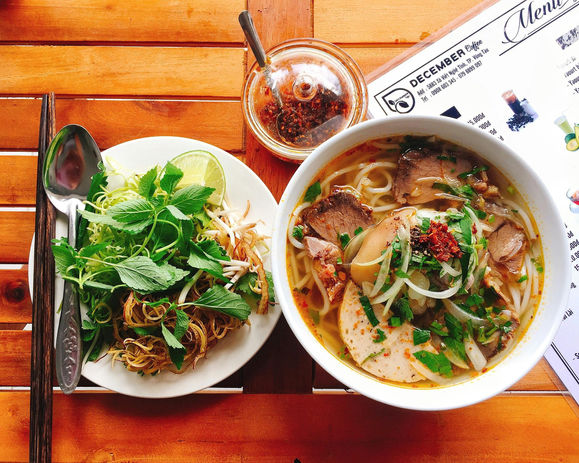Food & Dining Tips in Vietnam
Food and Dining in Vietnam
Guide for Expats Vietnam’s vibrant food culture is a highlight for expats living in the country. From street food to fine dining, the culinary options are vast and diverse. This guide will help you explore Vietnam’s culinary wealth, stay safe while enjoying local cuisine, and find restaurants that cater to your dietary preferences.
1. Exploring Vietnamese Cuisine
Vietnamese food is a perfect blend of flavors, textures, and freshness. Here are some must-try dishes:
Phở: A fragrant noodle soup with beef (phở bò) or chicken (phở gà).
Bánh mì: A Vietnamese sandwich filled with meats, pickled vegetables, and herbs in a crispy baguette.
Gỏi cuốn: Fresh spring rolls made with shrimp, pork, and herbs, served with peanut dipping sauce.
Bún chả: Grilled pork served with rice noodles, fresh herbs, and dipping sauce.
Cà phê sữa đá: Vietnamese iced coffee with condensed milk.
2. Food Safety Tips
Enjoying local food is part of the adventure, but staying safe is essential:
Choose Busy Vendors: Opt for street food stalls with high turnover to ensure freshness.
Look for Hygiene: Check that vendors wear gloves and use clean utensils.
Drink Bottled Water: Avoid tap water and ice unless you’re sure it’s purified.
Wash Fresh Produce: If cooking at home, thoroughly wash fruits and vegetables or use filtered water if possible.
Beware of Raw or Undercooked Foods: Stick to well-cooked dishes to avoid foodborne illnesses.
3. Finding Restaurants for Various Dietary Needs
Vietnam’s dining scene caters to a wide range of dietary preferences:
Vegetarian/Vegan: Look for "Quán Chay" (vegetarian restaurants). Popular spots include Hum Vegetarian (Ho Chi Minh City) and An Lạc Chay (Hanoi).
Gluten-Free: Many traditional Vietnamese dishes like phở and gỏi cuốn are naturally gluten-free. Inform the staff by saying, “Không ăn bột mì” (I don’t eat wheat flour).
Halal: Halal-certified restaurants are available in major cities. Check out Halal Saigon or Red House in Ho Chi Minh City.
Western Cuisine: For a taste of home, cities like Hanoi, Ho Chi Minh City, and Da Nang have restaurants serving pizza, burgers, and other Western dishes.
4. Top Dos and Don’ts for Food and Dining
Dos
Do try street food: It’s an essential part of Vietnamese culture and often the most authentic.Do bargain at markets: Polite bargaining is expected when buying fresh produce or snacks. However, it is unlikely for non-Vietnamese speaking foreigners to bargain in a food market. Some markets selling T-shirt, shoes targeting tourist have English-speaking sales assistants. You are more likely to bargain hard (30-50%) in that situation.Do tip: While not mandatory, tipping 5-10% at restaurants or spa services is appreciated.Do ask for recommendations: Locals often know the best spots for authentic food.
Don’ts
Don’t eat at empty stalls: Low turnover may indicate less fresh food.
Don’t leave valuables unattended: Overcharging or theft can occur in busy areas.
Don’t assume all food is spicy: Always ask, “Có cay không?” (Is it spicy?) if you’re unsure.
Don’t forget to check the price: Confirm prices before ordering, especially at tourist hotspots.
5. Understanding Dining Etiquette
Sharing is Caring: Meals are often shared family-style. Use serving utensils instead of your own chopsticks.
Don’t Stick Chopsticks Upright: It’s considered bad luck, as it resembles incense for the dead.
Paying the Bill: The host usually pays, but splitting the bill is becoming more common among younger people.
6. Recommended Food Apps and Resources
Foody.vn: A popular app for finding restaurants, reviews, and delivery services.
GrabFood: Convenient for food delivery from local restaurants.
HappyCow: Great for locating vegetarian and vegan dining options.
Local Facebook Groups: Join expat or foodie groups for up-to-date recommendations.
7. Religious and Spiritual Practices
Buddhism and Ancestor Worship: Many Vietnamese follow Buddhist practices and honor their ancestors. Respect altars in homes and public spaces by not touching or pointing at them.
Temple Etiquette: Remove your shoes before entering a temple. Keep your voice low and avoid taking photos unless explicitly allowed.
Culinary Experience
Vietnam’s culinary scene is a treasure trove waiting to be explored. By following these tips, you can enjoy the diverse flavors of Vietnam while staying safe and avoiding common pitfalls. Bon appétit, or as locals say, Chúc ngon miệng! You can also join our VIP Membership where we can recommend organised culinary tours for foreigners.


